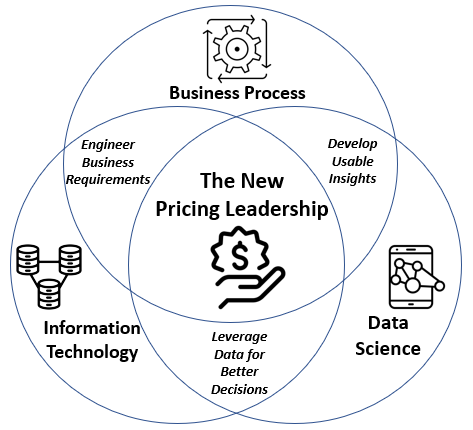The role of Pricing Leader has shifted rapidly in recent years and promises to continue to do so along lines formed by the intersection of Big Data, cloud-based technologies and evolving business processes.
This intersection will put real-time dynamic pricing in the hands of those who need it most (pricing managers, product managers, account managers, salespeople) while providing a competitive advantage to companies who choose to develop pricing leaders with these three critical competencies.
B2B companies that realize the importance of this role and how it enables the enterprise to capture incremental revenue and expand margins will be best positioned to grow market share, increase profits and outperform their peers in all business cycles.

Business Process
Pricing projects in the future will require new capabilities, which can mean an “upgrade” to the pricing role. Fundamentally, pricing leaders need a deep understanding of the pricing function and core knowledge and expertise in the company’s products and business processes. And while this user-orientation and deep domain knowledge are the basic requirements, they will also benefit from a big-picture philosophy around how pricing integrates with other key functions and drives growth and profitability across the enterprise.
Critically, pricing leaders must be able to engineer business processes that drive process efficiencies and effective pricing decisions. And often these processes touch multiple departments, business systems and data sources. This makes depth and breadth of knowledge across the various business silos an important skill set for today’s successful pricing leader.
Information Technology
Today’s pricing projects are skill-based and technology-intensive activities. Recent advances in software and hardware have done much to improve the accessibility of data and the usability of new software technologies. However, their successful application in the pricing realm requires people who understand the capabilities and limitations of technology solutions, as well as how to get the most out of available tools.
Pricing leaders must develop technology fluency and possess fundamental knowledge in areas such as software development and business process automation (CRM, ERP, CPQ, SFA). They may need to lead IT projects; at a minimum, they must be able to help IT staff translate business requirements into complex technical requirements that can be engineered for effective user experiences and pricing outcomes, and especially for the users of real-time pricing data.
Data Science
Pricing leaders will need to become more fluent in basic data science concepts. Often this includes at least some familiarity with statistical applications and data science tools (SAS, R, Python), data modeling and analytical techniques (rules, regression, optimization, etc), fast data processing, and database structure and design. Additionally, they must understand how data science techniques are used to extract valuable insights from various data stores. An important new requirement in digital pricing projects is to access data from silos across the organization, and even outside the organization (competitive data, for example) and bring it together in a unified, accessible form.
While pricing leaders need not be actual data scientists, they do need to understand how data science unlocks new insights from existing data, and possibly to propose new data sources as well as use cases that can enhance the application of analytical techniques and efficient algorithms for better decisions. Effective pricing leaders will need the ability to frame or translate business problems in a way that data scientists can understand in order to help refine models that improve results.
Conclusion
Companies embarking on transformational pricing projects (whether business-line focused or enterprise-wide) should recruit pricing leaders who integrate these three disciplines into their role. Specific classroom-based and experiential training options tailored to these areas are available for existing pricing leaders.
In addition, it is critical to expose pricing leaders to events that provide a venue for sharing functional and industry best practices, capability building, technology exposure, learning and development and networking opportunities that link them to others in a similar role that are also building out their skills.
Today’s pricing realities are different than those of the past. It is critical to coach, mentor and train high performers in the workplace who can succeed as a pricing leader in the future. Because the future...is actually now.
About the Author
Kyle Nations is Sales Director at Zilliant helping global B2B companies realize improved financial performance using advanced technology for optimal pricing & sales effectiveness.
